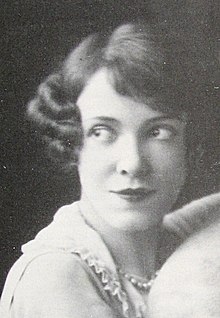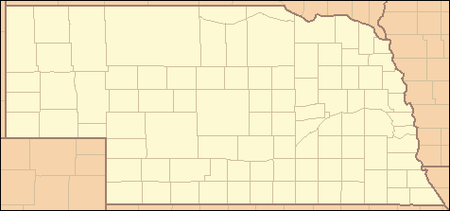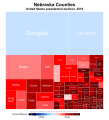Portal:Nebraska
The Nebraska PortalMigrating sandhill cranes (Antigone canadensis) depart their overnight roosting area in the Platte River near Kearney, Nebraska, at dawn (2015).
 Nebraska (/nəˈbræskə/ nə-BRASS-kə) is a landlocked state in the Midwestern region of the United States. It borders South Dakota to the north; Iowa to the east and Missouri to the southeast, both across the Missouri River; Kansas to the south; Colorado to the southwest; and Wyoming to the west. Nebraska is the 16th-largest state by land area, with just over 77,220 square miles (200,000 km2). With a population of over 1.9 million, it is the 38th-most populous state and the eighth-least densely populated. Its capital is Lincoln, and its most populous city is Omaha, which is on the Missouri River. Nebraska was admitted into the United States in 1867, two years after the end of the American Civil War. The Nebraska Legislature is unlike any other American legislature in that it is unicameral, and its members are elected without any official reference to political party affiliation. Nebraska is one of only two states that divide electoral college votes by district, and is not winner-take-all. Nebraska is composed of two major land regions: the Dissected Till Plains and the Great Plains. The Dissected Till Plains region consists of gently rolling hills and contains the state's largest cities, Omaha and Lincoln. The Great Plains region, occupying most of western Nebraska, is characterized by treeless prairie. Eastern Nebraska has a humid continental climate while western Nebraska is primarily semi-arid. The state has wide variations between winter and summer temperatures; the variations decrease in southern Nebraska. Violent thunderstorms and tornadoes occur primarily during spring and summer, and sometimes in autumn. The Chinook wind tends to warm the state significantly in the winter and early spring. Indigenous peoples, including Omaha, Missouria, Ponca, Pawnee, Otoe, and various branches of the Lakota (Sioux) tribes, lived in the region for thousands of years before European discovery and exploration. The state is crossed by many historic trails, including that of the Lewis and Clark Expedition. The completion of the Transcontinental Railroad through Nebraska and passage of the Homestead Acts led to rapid growth in the population of American settlers in the 1870s and 1880s and the development of a large agriculture sector for which the state is known to this day. (Full article...) Selected article -Lincoln is the capital of the U.S. state of Nebraska and the county seat of Lancaster County. The city covers 100.4 square miles (260.035 km2) and had an estimated population of 294,757 in 2023. It is the state's second-most populous city and the 71st-largest in the United States. Lincoln is the economic and cultural anchor of the Lincoln Metropolitan and Lincoln-Beatrice Combined Statistical Areas, home to 361,921 people. Lincoln was founded in 1856 as the village of Lancaster on the wild salt marshes and arroyos of what became Lancaster County. Renamed after President Abraham Lincoln, it became Nebraska's state capital in 1869. The Bertram G. Goodhue–designed state capitol building was completed in 1932, and is the nation's second-tallest capitol. As the city is the seat of government for the state of Nebraska, the state and the U.S. government are major employers. The University of Nebraska was founded in Lincoln in 1869. The university is Nebraska's largest, with 26,079 students enrolled, and the city's third-largest employer. Other primary employers fall into the service and manufacturing industries, including a growing high-tech sector. The region makes up a part of what is known as the Midwest Silicon Prairie. (Full article...) Selected biography -Adele Astaire Douglass (born Adele Marie Austerlitz, later known as Lady Charles Cavendish; September 10, 1896 – January 25, 1981) was an American dancer, stage actress, and singer. After beginning work as a dancer and vaudeville performer at the age of nine, Astaire built a successful performance career with her younger brother, Fred Astaire. The brother and sister act initially worked their way through vaudeville circuits, finally achieving a breakthrough with their first Broadway roles in 1917. Astaire became known for her talents as a skilled dancer and comedienne, starring in hit Broadway musicals such as Lady, Be Good! (1924), Funny Face (1927) and The Band Wagon (1931). The siblings took several of their more popular shows to Britain's West End during the 1920s, where they were soon international celebrities, meeting members of the British royal family and prominent figures from contemporary arts and literature circles. (Full article...) Counties (clickable map)General images -The following are images from various Nebraska-related articles on Wikipedia.
Did you know -
Related portalsTopicsLargest cities
CategoriesNew articlesThis list was generated from these rules. Questions and feedback are always welcome! The search is being run daily with the most recent ~14 days of results. Note: Some articles may not be relevant to this project.
Rules | Match log | Results page (for watching) | Last updated: 2024-11-20 21:54 (UTC) Note: The list display can now be customized by each user. See List display personalization for details.
WikiProjectsAssociated WikimediaThe following Wikimedia Foundation sister projects provide more on this subject:
Sources
|






































